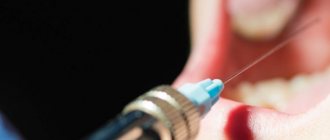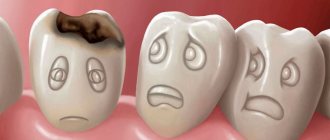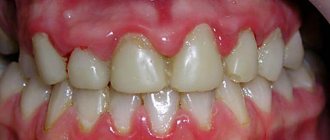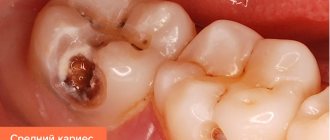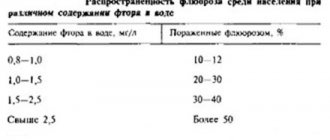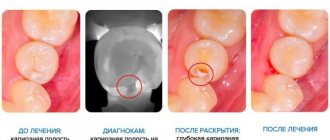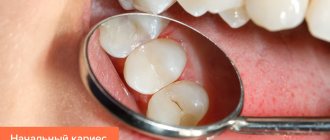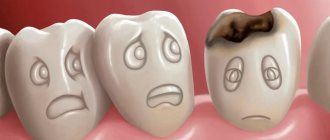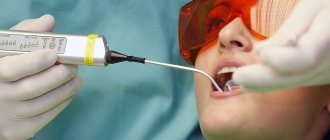When a tooth decays unnoticed, it is considered hidden caries. This name is not used in the specialized literature, but in everyday life of working dentists it is used quite often. To identify this disease, it is necessary to use special diagnostic techniques. For example, it can be difficult to notice caries that has appeared in the gap between the teeth, where food debris gets stuck. Due to the invisibility of caries, which occurs latently, the patient often does not even suspect that he has this disease.
Location of bacteria
Based on the location of hidden caries, it is divided into:
- Contact, located in the space between the teeth. The disease becomes noticeable to a person only after it completely affects the tooth and the onset of severe pain. During the examination, the dentist can determine the onset of hidden caries in the primary stages of the disease. The cause of such caries is the constant presence of food debris between the teeth. Treatment of contact caries is a very unpleasant process.
- Fissure, located in the fissures - cavities of the teeth. It appears as a small darkened spot on the tooth enamel. If you notice it, you should urgently go to the doctor so that the disease does not begin to progress. If the darkened area breaks off, severe pain will begin. This type of caries is treated quite simply.
- Root caries, which affects the root of the tooth, is a very dangerous and difficult to treat disease. It is detected only when not only the root part is affected, but the entire tooth. At the same time, periodontitis usually begins, the root moves away from the gum, becomes exposed and collapses. Often, such caries leads to the loss of the diseased tooth.
- Secondary, developing under the filling. It is detected when pain begins or when a filling is lost due to the growth of the affected cavity. During a preventive examination, it is possible to detect the disease at the initial stage.
The causes of hidden caries are varied. Among them are failure to comply with hygiene rules, sweet foods, lack of vitamins, calcium and fluoride. At the same time, the teeth are poorly cleaned of stones, bacteria multiply in the mouth, and cavities affected by caries develop.
Kinds
Dentists classify hidden forms of caries as follows:
- contact (the infection quickly moves to neighboring units and is difficult to diagnose);
- lesions of the root zone (carious lesions occur in places hidden under the soft tissue of the gums);
- secondary (occurs in previously treated areas);
- fissure (reproduction of pathogenic bacteria occurs in microcracks in the enamel).
It is extremely difficult to diagnose all of the listed types of caries, so it is not always possible to detect it in time and effectively treat it.
Symptoms and course of the disease
Hidden caries does not appear in the initial stages of the disease and becomes noticeable only after serious damage to the dental tissue. There is no pain, dental lesions are not visible in the mirror. Now, if a filling falls out, this is already an important symptom, meaning that caries is developing. The enamel becomes spotted.
If caries has progressed far, the tooth begins to hurt severely due to temperature changes, from sweet or salty foods. At the same time, the tooth itself does not hurt, only from various causes. When the irritant disappears, the pain immediately goes away. If pain begins to appear on its own, it means that caries has already turned into pulpitis, and the tooth tissue has begun to become inflamed.
If you press on the affected area (chewing food), it also responds with pain. The reason for this is that food penetrates the hole and compresses the vessels and nerves of the pulp. If the remaining food is removed from the affected area, the pain will go away.
General overview
From the point of view of the nature of origin, hidden and open forms of caries differ little from each other. The main criterion is the localization of the disease and the degree of its development. In the second case, we are talking about a pathological condition manifested by:
- In areas of contact between adjacent elements of the dentition, as well as on their reverse side, which significantly complicates the diagnosis and contributes to the rapid progress of the pathology.
- In areas of loose fit of a filling or artificial crown to the stump of a prepared tooth. Pathogenic bacteria entering small gaps and holes stimulate the development of negative processes that destroy the enamel structure.
- In the parts of the crown located under the gum tissue. The formation of gum pockets interferes with the full hygienic treatment of the row, resulting in an accumulation of organic particles in which infectious agents accumulate.
- In the fissure formations of the posterior part of the row. Problematic access and the complexity of visual diagnosis lead to late detection of caries, requiring in-depth treatment.
Practice shows that the long course of the pathology causes extensive damage, as a result of which, in order to save the tooth, it is necessary to remove a large part of the crown, as well as to carry out restorative procedures that are characterized by increased complexity. In some cases, treatment becomes impossible - in the presence of such indications, the only option is extraction of the problem unit and its subsequent replacement with a prosthetic structure.
Diagnosis of hidden caries
Modern diagnostic techniques make it possible to identify a cavity in a tooth affected by caries at any stage of its development. Another thing is that the doctor uses these techniques when there is a suspicion of caries. And these suspicions are precisely difficult to identify - the tooth does not hurt, and the patient is not worried. So often caries remains unnoticed and actively grows. Hidden caries can coexist with ordinary caries, the damage from which is quite noticeable. If there is a lot of tooth decay, an experienced dentist will definitely check for hidden lesions. Diagnostics can be carried out using various methods:
- Laser is very reliable. A special device “Diagnodent” directs a laser beam at the tooth and analyzes the resulting reflection from the tooth being examined.
- X-ray detects lesions in hard-to-reach places, but not in the early stages of development.
- Visual examination with a mirror is the primary method of diagnosis. If the doctor begins to suspect something after the examination, he prefers to use other techniques.
- Transillumination, when the tooth is illuminated with bright light. A photopolymerization lamp can be used for this.
Treatment options
A hidden type of caries is treated like any other: damaged tooth tissue is removed and the tooth is filled. If the enamel is damaged or stains appear on it, the tooth must be opened. Products containing calcium and fluoride help restore enamel. When caries forms behind the filling, the cavity is cleaned out and the filling is installed again. This process is done under local anesthesia.
If the disease is advanced, the doctor removes the affected tissue and puts on a crown. Treatment may include tooth extraction and installation of an implant.
Case from practice. There is a whole tooth between the teeth that have caries. Due to suspicion of infection of the tooth, an X-ray examination was performed, which revealed damage to the tooth tissue. The pulp remained intact, but the bone substance was cleaned and the tooth was filled.
What causes the disease?
Hidden caries can be caused by various reasons. Let's consider the main ones:
- poor oral hygiene;
- abuse of sweets;
- presence of gastrointestinal diseases;
- insufficient amount of vitamins in the body;
- weakened immune system;
- improper formation of dental organs;
- lack of calcium, fluorine and phosphorus in drinking water.
The listed factors lead to the proliferation of pathogenic bacteria in the oral cavity, which leads to the formation of hidden cavities from caries.
Possibility of complications
Complications after caries are varied:
- allergy to a developing infection;
- development of inflammation of the gums and facial tissues;
- an infected tooth affects the condition of the body;
- the appearance of flux is possible;
- A jaw cyst may develop.
Painful sensations do not allow high-quality chewing of food, which harms the stomach and intestines. Damage to a tooth can lead to its removal, and this is a serious stress received by the body. Complications can be very serious diseases - pulpitis and periodontitis. With pulpitis, pain appears when biting; this disease can manifest itself even after treatment of caries if the affected tissue is removed poorly. An even more serious complication is periodontitis, which affects nerve bundles and ligaments. Left untreated, it can become a chronic disease.
Preventive measures
To protect yourself from hidden caries, you need to visit your doctor regularly. If for an adult it is enough only once every 6 months, then a child should undergo preventive examinations every 3-4 months. This is explained by the fact that periodontal tissues at a young age are not yet fully formed and are more quickly susceptible to negative influences, so tooth decay occurs much faster.
It is also important to follow tips for caring for your teeth and gums at home. Cleansing only in the morning and before bed is not enough; hygiene procedures are also necessary after every meal and consumption of drinks containing sugar. Threads and irrigators will allow you to remove food particles from the interdental spaces, fissures and from the inside of the row.
You will also have to reconsider your usual diet. To prevent tooth decay, eat plenty of fresh fruits and vegetables. Solid products help to naturally cleanse plaque from enamel. It is necessary to avoid sudden changes in temperature, that is, you should not eat ice cream and wash it down with hot coffee. Preventing caries is much easier than dealing with its consequences later. Lack of timely treatment can lead to periodontitis and pulpitis, that is, serious inflammatory processes.
previous post
How to stop tooth decay
next entry
Prevention measures
To prevent hidden caries from appearing, you must adhere to the following rules:
- Brush your teeth at least twice a day, paying attention to cleaning hard-to-reach surfaces like the space between your teeth. It is advisable to choose the right toothbrush and toothpaste.
- Drink water that contains fluoride. If there is not enough of this element in the water, the tooth enamel will gradually deteriorate. Drinking water must be fluoridated or seafood must be included in the diet. They also use special rinses.
- Do not eat food that has a high or low temperature; it can cause microcracks to appear on the enamel, into which microorganisms that cause caries can penetrate.
- Visit your dentist twice a year for a physical examination. In this case, dental diseases can be detected in time and treated without any special consequences. When plaque appears on your teeth, you need to have your teeth professionally cleaned and prevent bacteria from spreading.
The result exceeded the patient's expectations
Let's now look at the work from all sides to see all the beauty, aesthetics, and masculine charm of veneers
:
The work took 19 days
, we completely restored all function and raised the height of the bite. The before and after photos clearly show how the face changes after the bite height is restored:
19 days in a very comfortable mode for the patient. There is no need to try to fit all the primary dental treatment into one day, since grinding 20 teeth at once is very difficult, the patient must sit for several hours with his mouth open, which is psychologically and physically difficult: the neck and back become stiff, it is uncomfortable for the spine , and not very good for the cardiovascular system.
Vitaly and I had 4 comfortable visits
my office:
- The first visit
is taking impressions and taking a photo protocol, it took 30 minutes - Second visit
- top turning and temporary top, - The third visit
is fixing the top, turning the bottom and temporary bottom - And the fourth visit
- the temporary bottom was removed and the permanent bottom was fixed.
